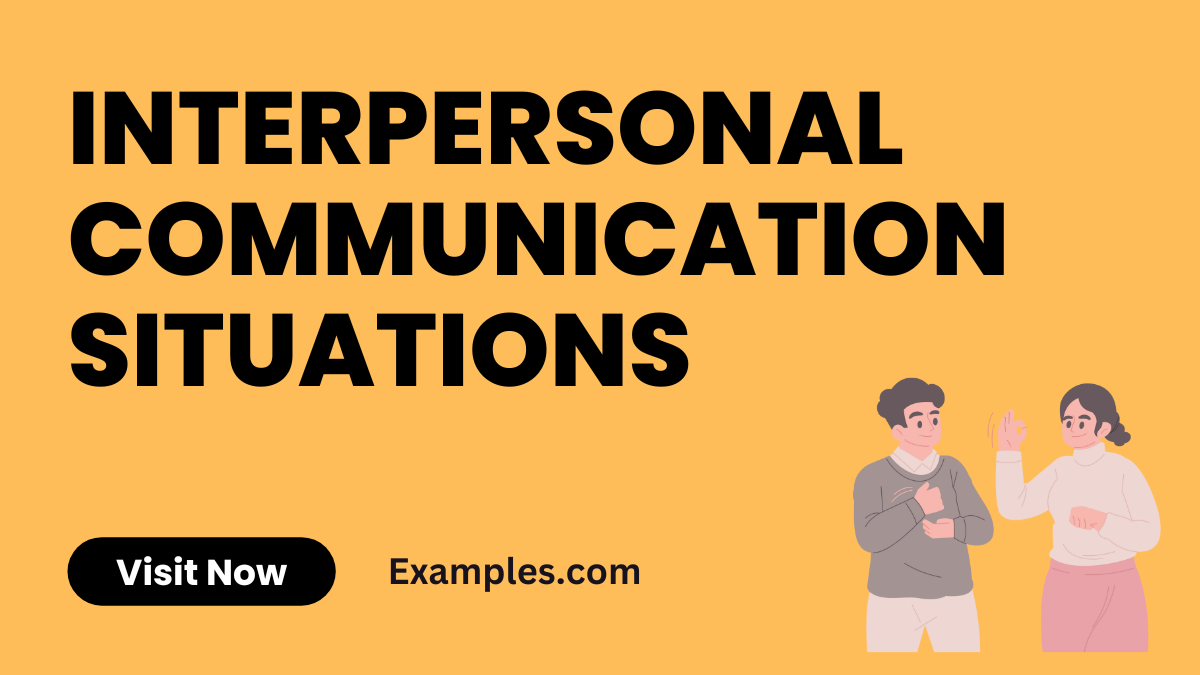24+ Interpersonal Communication Situations Examples
Embark on a journey through various interpersonal communication situations with this comprehensive guide. Each scenario is paired with a practical communication example, illustrating effective ways to navigate and excel in diverse communication challenges. Whether in personal relationships, professional environments, or social gatherings, understanding these situations enhances your ability to connect and interact effectively. This guide serves as a valuable resource for anyone looking to sharpen their interpersonal communication skills.
What are Interpersonal Communication Situations?

Interpersonal Communication Situations refer to various scenarios where two or more people interact and communicate with each other. These situations can range from casual conversations with friends to formal discussions in a professional setting. Understanding these situations involves recognizing the context, the people involved, and the most effective communication strategies to use. It’s about adapting your communication style to suit different scenarios, ensuring that your message is conveyed clearly and effectively.
25 Examples of Interpersonal Communication Situations

- Networking Events: A scenario where building professional relationships is key.
Example: “At the event, I introduce myself and ask about others’ work.” - Job Interviews: A formal setting where clear and confident communication is essential.
Example: “I answer interview questions concisely, showcasing my skills and experience.”

- Team Meetings: Collaborative environments where sharing ideas and feedback is important.
Example: “I actively contribute and listen to team members’ suggestions.” - Conflict Resolution: Situations requiring calm and constructive communication.
Example: “I approach conflicts seeking understanding and common ground.” - Family Discussions: Casual yet important conversations needing empathy and patience.
Example: “I listen to family members’ viewpoints and express my thoughts respectfully.” - Public Speaking: Addressing an audience with clarity and confidence.
Example: “I engage the audience with relevant stories and clear points.” - Customer Service: Handling customer queries and complaints with professionalism.
Example: “I respond to customers with empathy and offer practical solutions.” - Romantic Relationships: Conversations requiring honesty, understanding, and emotional expression.
Example: “I communicate my feelings openly and listen to my partner’s needs.” - Medical Consultations: Patient-doctor interactions where clear information exchange is crucial.
Example: “I explain medical conditions and treatments in an understandable way.”

- Academic Group Projects: Coordinating and collaborating with classmates.
Example: “I discuss project roles and responsibilities with my group.” - Sales Pitches: Convincing potential clients or customers with persuasive communication.
Example: “I highlight product benefits tailored to the client’s needs.” - Parent-Teacher Meetings: Discussing student progress with understanding and clarity.
Example: “I share student achievements and areas for improvement.”

- Social Gatherings: Engaging in light, friendly conversations in informal settings.
Example: “I chat about common interests and share personal anecdotes.” - Counseling Sessions: Providing support and guidance through empathetic listening.
Example: “I create a safe space for clients to express their feelings.” - Negotiations: Seeking mutually beneficial solutions through assertive yet respectful dialogue.
Example: “I negotiate by focusing on win-win outcomes for all parties.” - Online Communication: Emailing or messaging with clarity and etiquette.
Example: “I ensure my digital messages are clear and polite.” - Community Events: Interacting with diverse groups in a community setting.
Example: “I participate in discussions and activities with community members.” - Crisis Communication: Addressing urgent situations with calm and clear directives.
Example: “In a crisis, I communicate instructions clearly and calmly.” - Media Interviews: Representing oneself or an organization in media interactions.
Example: “I address media questions with prepared and concise responses.” - Peer Feedback Sessions: Providing constructive feedback in a supportive manner.
Example: “I offer feedback that is specific, helpful, and encouraging.” - Cultural Exchange Programs: Communicating across cultural differences with sensitivity.
Example: “I respect cultural nuances and adapt my communication style.” - Coaching and Mentoring: Guiding others through encouraging and insightful communication.
Example: “I mentor by asking questions that provoke thought and growth.” - Personal Development Workshops: Participating and engaging in self-improvement activities. Example: “I share experiences and insights to contribute to the workshop.”
- Corporate Training Sessions: Learning and discussing new skills in a professional environment. Example: “I actively engage and apply new skills in training sessions.”
- Legal Consultations: Communicating legal advice clearly and comprehensively.
Example: “I explain legal options and implications to clients clearly.”
Interpersonal Communication Situations in the Workplace
- Team Meetings: Regular team meetings are a common scenario for exchanging ideas, updates, and feedback. Effective interpersonal communication ensures that all voices are heard, fostering collaboration and problem-solving.
- Conflict Resolution: Workplace conflicts, whether between colleagues or departments, require careful communication to resolve. Active listening and empathy are key to finding mutually beneficial solutions.
- Performance Reviews: These involve providing feedback to employees. Clear, constructive communication helps in setting goals and encouraging professional growth.
- Networking Events: Interactions at networking events require adaptability and the ability to engage in small talk, crucial for building professional relationships.
- Client Meetings: Meeting with clients demands professionalism and the ability to clearly communicate service offerings and understand client needs.
- Email Correspondence: Daily email exchanges require concise and clear written communication to convey messages effectively and maintain professionalism.
- Training Sessions: Whether leading or attending, training sessions require clear articulation and the ability to understand and convey complex information.
- Crisis Communication: Handling workplace crises requires calm, clear, and direct communication to navigate through challenging situations effectively.
- Interdepartmental Collaboration: Working with different departments involves understanding varying perspectives and communicating ideas in a way that resonates across teams.
- Employee Onboarding: Introducing new employees to the company culture and processes requires effective communication to ensure a smooth transition into their roles.
Interpersonal Communication Situations in Everyday Life
- Family Discussions: Regular conversations with family members about daily activities, plans, and concerns involve sharing and listening, crucial for maintaining strong family bonds.
- Social Gatherings: Interacting with friends or acquaintances at social events requires the ability to engage in casual conversation, share experiences, and listen actively.
- Conflict Situations with Neighbors: Resolving issues with neighbors demands diplomacy and the ability to communicate grievances respectfully.
- Parent-Teacher Meetings: These require clear communication about a child’s academic and social development, highlighting the importance of collaboration between parents and educators.
- Shopping and Services: Communicating with salespeople or service providers requires clarity in expressing needs and understanding the information provided.
- Medical Appointments: Discussing health concerns with healthcare professionals requires the ability to describe symptoms accurately and understand medical advice.
- Public Speaking: Opportunities like community events or local gatherings demand effective public speaking skills to convey messages clearly to an audience.
- Traveling: Communicating in different cultural contexts while traveling involves adaptability and often non-verbal communication skills.
- Online Interactions: Engaging in digital communication through social media or forums involves understanding the tone and context of written words.
- Emergencies: Handling emergency situations requires calm and clear communication to convey critical information and seek help effectively.
In conclusion, this article offers a comprehensive guide on various Interpersonal Communication Situations, providing valuable insights and practical examples. Whether in the workplace, everyday life, or specific scenarios like job interviews, medical consultations, and parent-teacher meetings, effective interpersonal communication plays a pivotal role. This guide equips readers with the knowledge and tools to navigate these situations successfully, enhancing their communication skills and fostering better understanding and relationships in diverse settings.



